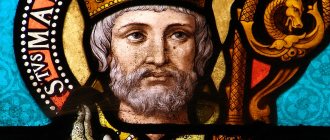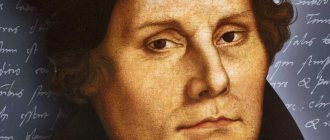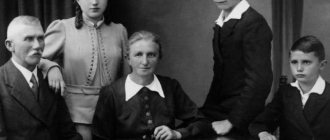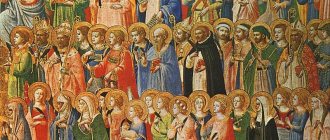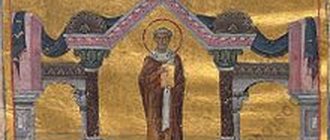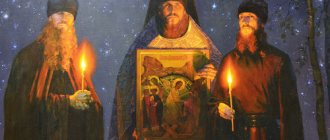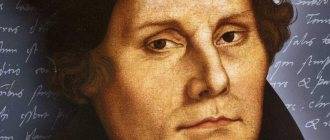Martin the Confessor, Pope
Martin the Confessor was born in the city of Tudertuma in the Umbrian region of Italy at the beginning of the 7th century. Having received a good education, he became a clergyman of the Roman Church. After the death of Pope Theodore I in 649, the then priest Martin was elected as the new pope.
The Church at that time was torn apart by the Monothelite heresy, which spread widely throughout the empire. The Monothelites asserted that Jesus Christ had only one - Divine - will. Heated debates between Monothelites and Orthodox Christians took place in all segments of the population. Even Emperor Constance and Patriarch Paul II of Constantinople were adherents of this heresy. The Emperor issued a heretical "Model of Faith", which was forcibly distributed and binding on the entire population. It, in particular, prohibited any further disputes.
This "Model of Faith" reached Rome in 649. Saint Martin, a strong defender of Orthodoxy, convened a Local Council in Rome, which condemned the Monothelite heresy. Martin called upon Patriarch Paul to return to the Orthodox confession. Angered by the act of Pope Martin, the emperor sends a military leader, Exarch of Ravenna Olympius, to bring Martin to trial. But he, once in Rome, was frightened by the number of clergy and people at the Council, and bribed a soldier to secretly kill the pope confessor. But the killer, approaching Martin, suddenly lost his sight. Frightened, Olympius hastily left for Sicily, where he was soon killed in battle.
In 654, Emperor Constance sent another military leader, Exarch Theodore I Calliope, to the Pope with serious accusations of secret communication between Saint Martin and the enemies of the empire - the Saracen Arabs, of blaspheming the Most Holy Theotokos, and of uncanonical accession to the papal see. Despite the existence of clear evidence of Martin’s complete innocence, Theodore and a detachment of soldiers captured the saint at night and sent him to one of the Cyclades islands of Naxos in the Aegean Sea. Saint Martin was kept for about a year on this deserted, remote island, enduring numerous hardships. The already completely exhausted confessor was then finally sent to Constantinople for trial.
At the trial, no one even listened to the excuses of the sick and elderly Martin. After the guilty verdict was handed down, the saint, in torn clothes, was exposed to the ridicule of the crowd, who were encouraged to shout at him: “Anathema!” Finally, a church official, at the direction of the emperor, announced the verdict: to deprive Pope Martin of his rank and put him to death. The saint was chained and put in prison with murderers and robbers sentenced to death.
Meanwhile, Emperor Constance learned of the request of the dying and repentant Patriarch Paul on his deathbed to stop the torment of Saint Martin. The Emperor returned the imprisoned Martin for further interrogation. However, Pope Martin declared to all his interrogators: “Even if they crush me, I will not be in communion with the Church of Constantinople while it remains in evil faith.” The death penalty was nevertheless replaced for the confessor by exile to the Crimea, to Chersonese Tauride.
There the saint died of illness on September 16, 655. After the condemnation of the Monothelites, his relics were transferred to Rome.
MARTIN I
17 Sep. 653/4, a ship with M. on board arrived in the K-Polish harbor of St. Euphemia, located near the palace of Arkady (Arkadion). The military accompanying the pontiff went ashore to receive further instructions. The news of his arrival spread throughout the city, and many residents of K-field gathered in the harbor, some of whom mocked M., while others expressed sympathy for him. Further events are known from another letter from M. to the monk. Theodore, as well as from the “Memoirs” (“Commemoratio”), which represent lit. reworking of the interrogation recording prepared by a supporter of M. “Memoirs”, translated into Lat. language by Anastasius the Librarian († between 877 and 879), and letters from M. addressed to mon. Theodore, were included in the “Narrative of the Exile of St. Martin” (for more details, see the section “Veneration of M.”). Anastasius the Librarian attributed the authorship of the “Memoirs” to Theodore Spudei, a cleric of the Church of St. Sophia in K-pol, who is known as the author of the description of the interrogation and trial of St. Maximus the Confessor (CPG, N 7968) and whom Anastasius the Librarian identified with the addressee of M’s letters. However, judging by the contents, he was a Roman, not a Polish monk.
In the evening M. was transferred to Prandearia prison. Dad was in solitary confinement, but his whereabouts became known, and M.’s supporters were able to communicate with him. It was here that he composed letters to Mon. Theodora. In M.'s prison, some details of the charges brought against him became known, although even Theodore Calliope, in conversations with the pope, tried to limit himself to general phrases. The accusations were mainly of a political nature (M. allegedly maintained contact with the Arabs), although the pope was also accused of separating the Divine and human natures in Christ, understanding the human composition of the Lord only as a created shell for the Divinity, born of the Most Holy One. Virgin Mary. M. demonstrated the absurdity of these accusations in the 1st Epistle to Mon. Theodora.
The pope spent 93 days in custody, after which his interrogations began. On Friday, December 19th 653/4 M. was taken to the residence of the sacellarium of Vukolion. There he appeared before the court of the K-Polish Synclite (Senate). According to procedural norms, M. was required to stand up, but due to illness and due to his advanced age, he could hardly stand on his feet; he was supported by 2 guards. Consul Innocent from Africa acted as a translator. Sacellarius Vukolion, who was entrusted with leading the meetings, asked M. the question required by protocol: “Tell me, unfortunate one, what bad did the emperor do to you? Did he offend you in any way? Did he oppress you? Since M. was silent, the sacellarius ordered the accusers to be brought in. The main accusers were Byzantine military men from Italy. Since many of them served under the usurper Olympia, and after his death they went to serve the emperor. Constant II, they sought to make amends to the authorities in K-pol. The Pope was skeptical about these witnesses, and also asked the judges not to force them to take an oath, etc. destroy your souls.
The accusation of conspiracy with the usurper Olympius was formulated by the patrician of Sicily Dorotheus and confirmed several times. witnesses. When pressed for an answer, M. tried to concentrate on the question of faith and began to recount the history of the events that followed the sending of the Typos to Italy. This caused indignation among the senators, who said that they demanded that M. respond to a specific accusation and did not intend to listen to his theological reasoning. Eparch (prefect of the K-field) Troilus emphasized that discussions about faith in this case do not make sense, since all those present are “Romans” professing the same faith, which M. doubted. Troilus again asked why M., knowing about Olympius’s intentions to seize power, did not prevent this, but, on the contrary, entered into an agreement with him. Realizing the vulnerability of his position on this issue, M. tried to move from defense to accusation of the judges. He remembered the events of 643, when he was an apocrisiary in K-pol. Then, as a result of a series of coups in the capital, the “committee of royal bounty” Philagrios and the strategist Valentin Arshakuni brought the young Constant II to power, while Valentin declared himself co-ruler of the young emperor. The pope asked Troilus and the other senators rhetorically why they had not prevented the usurpation at that time, but were now bringing similar charges against him. M. also asked those present how he could oppose Olympius when the entire army of Italy was on the side of the usurper. M.'s words confused the judges and prosecutors. However, Vukolion ordered the questioning of witnesses to continue. Since M. confidently defended himself and ridiculed those who accused him, the sacellar forbade the translation of the pope’s answers into Greek. language. Then M. was taken out of the building and placed under the guard of soldiers in full view of the crowd, who began to mock him.
Having received instructions from imp. Constant II, Vukolion announced that M.’s guilt had been proven, and ordered the soldiers to take him to the hippodrome, where the execution was to take place. The Emperor watched events from the window of his triclinium. Sacellarius Vukolion exclaimed: “You see what the Lord has brought you to by delivering you into our hands! You left God, and God left you!” After this, he ordered the papal pallium and other insignia to be torn from M. as a sign that he allegedly illegally occupied the Roman throne. Then the sacellarius handed M. over to Eparch Troilus for punishment and called on the crowd to curse him. By order of Troilus, an iron chain was put on M.; the soldiers dragged him through the streets of the city to the praetorium, where they placed him in a cell for criminals. Despite calls from the authorities, the crowd expressed sympathy for M., and only a few shouted curses at the pontiff. Perhaps for this reason imp. Constant II abandoned his intention to put M. to public execution. The death of the pontiff could lead to a surge of anti-imp. mood in Byzantium.
Spanish Martin I, Pope of Rome. Miniature from Greco-cargo. manuscripts. Con. XV century (RNB. O.I.58. L. 144) App. Martin I, Pope of Rome. Miniature from Greco-cargo. manuscripts. Con. XV century (RNB. O.I.58. L. 144)
An hour later M. was transferred from the praetorium to the Diomede prison. The pope's supporters came here, asking permission to bandage his wounds (only one cleric was allowed). Having waited until the prison warden left, the wife and daughter of one of the guards, who had the keys to M.’s cell, brought a blanket to the prisoner. In the evening, Cuvicularius Gregory came to prison. He ordered M. to be released from his shackles and given food, and also informed the prisoner that he would not be executed. Apparently 20 Dec. 653/4, the emperor visited the dying Patriarch Paul, who asked him to show leniency towards M. On the same day, the abolition of the execution was officially announced.
Former Patriarch Pyrrhus of Poland, after the death of Patriarch Paul, hoped to again occupy the see. It is not known whether M. and Pyrrhus met before this, but the pope was undoubtedly aware of Pyrrhus’s stay in Carthage, Rome and Ravenna in 645-646: the patriarch, deprived of his see, fled to Africa, renounced monothelitism there and was accepted into communion by Pope Theodore I in Rome, but then again went over to the side of monothelitism in Ravenna, for which he was excommunicated from the Church by the same pontiff, and then anathematized by M. and the Lateran Council of 649. The question of the past of Patriarch Pyrrhus, in particular about his stay in Rome, asked the pope the notary Demosthenes, who visited him in prison on January 8. 654/5 The pope's answers were respectful towards Pyrrhus, but were completely different from the version of events that the patriarch himself disseminated. According to the notary, Pyrrhus claimed that in Rome he was kept in wooden shackles and starved until he signed a confession of faith, in which he renounced Monothelitism. According to M.’s testimony, Pyrrhus voluntarily arrived in Rome, where he was recognized by Pope Theodore I as a bishop and was supported at the expense of the Roman Church, and wrote a confession voluntarily. To confirm the truth of his words, M. proposed to interrogate the then exarch Plato. The exposure of Pyrrhus' testimony about the oppression he allegedly suffered in Rome had no effect: January 4. 654/5, 9 days after the death of Patriarch Paul, Pyrrhus again occupied the K-Polish see. Soon Pyrrhus began to petition for M.'s expulsion from the capital, fearing that the pontiff might harm him. The Emperor was also inclined towards the same decision. Constant II.
Dad spent 85 days in Diomede's prison, after which he was transported to the house of the notary Sagoleba. After some time, M. was secretly transferred to a ship and sent to Kherson (Chersonese Tauride) - a place of exile for political criminals. Dad learned about the impending expulsion several months later. days before, but did not have the opportunity to warn his Polish supporters. Nevertheless, after arriving in Kherson, M. was able to establish contacts with them. 2 messages from M., written at this time, have been preserved (Jaffé. RPR. N 2080-2081). Their addressee is unknown, he is simply referred to as “beloved child” (possibly for security reasons). The messages survived because they were included in the Commemoratio. The first message was written a month after arriving in Kherson. M. reports his difficulties and need and is surprised that no help is coming to him from Italy. The second letter is dated Sept. 655 The Pontiff calls on all Christians to adhere to the Orthodox faith and wonders why the Roman Church does not help him in exile, although it has such an opportunity. Probably, shortly before that, M. learned about the election of Pope Eugene I (654-657); he expresses the hope that under the new pontiff Rome will remain faithful to Orthodoxy. M.'s correspondence from Kherson was probably more extensive. The author of “Commemoratio” mentions numerous letters from the pope, in which he complained of physical suffering and everyday inconveniences. In the addition to this work, made by another person, the exact date of M.’s death is indicated - September 16. 655, Memorial Day of the Military Medical Center. Euphemia All-Praised. The latter fact undoubtedly had symbolic meaning for the author, since the Council of Chalcedon met in a church dedicated to the martyr. M. was buried in the c. Our Lady of Blachernae, located one stage from Kherson.
Byzantine. authorities in Rome announced the deposition of M., who allegedly illegally ascended the Papal throne, back in June 653. It is unknown when Rome. the clergy decided to elect a new pope and what part the Byzantines took in this. Ordination of Eugene I, who received approval from the emperor without a candidate. difficulties, took place on August 10. 654 Apparently, his candidacy was acceptable to the Byzantines. authorities, and for the Romans: in Liber Pontificalis he is spoken of as a good man, who enjoyed universal respect (LP. T. 1. P. 341). The new pontiff sought to avoid conflicts with the Byzantines. In letters to Rev. Maximus the Confessor and in the report on his trial (Relatio motionis - CPG, N 7736) it is reported that the papal apocrisiaries in K-pol entered into communication with Patriarch Peter. Byzantine. the authorities monitored the situation in Rome and were ready to send a military expedition there if Eugene I tried to continue the policies of his predecessor (see: Sansterre J.-M. Eugenio I, santo // Enciclopedia dei Papi. R., 2000. Vol. 1. P. 603-606). However, anti-Byzantines dominated in Rome. sentiments reflected in the Liber Pontificalis, which speaks of a severance of communion with the Polish Church. The receipt of the synodics of Patriarch Peter, “completely inarticulate and not in accordance with the rules,” which did not speak of one or two wills in Christ, caused unrest among the clergy and people. The Romans did not allow Pope Eugene I to perform divine services in the Basilica of the Most Holy. Virgin Mary, until he promised that the synodics would be rejected (LP. T. 1. P. 341). Although relations between Rome and K-pol improved under Pope Vitalian (657-672), compilers of papal biographies were critical of the emperor's visit. Constantine (Constant II) to Rome in July 663 and about his stay in Italy (Ibid. P. 343-344). The biography of Pope Agathon (678-681) includes a detailed description of the VI Ecumenical Council, at which monothelitism and monoenergism were condemned; with this event rome. the authors linked the restoration of communication between the Papal See and the K-Polish See.
Despite the fact that the authors of the Liber Pontificalis shared the belief in the legitimacy of “most holy Martin, confessor of Christ,” and in the illegality of the actions of the Byzantines, they also recognized Eugene I as the legitimate pontiff. This is evidenced by indications of the duration of the pontificates of M. (6 years, 1 month and 26 days, i.e., until Aug. 30, 655) and Eugene I (2 years, 9 months, and 24 days, i.e., from Aug. 10, 655). 654).
I will not deviate from the gospel and apostolic teaching. Saint Martin the Confessor
Saint Martin the Confessor, Pope of Rome, was a native of the Tuscan region in Italy. He received a good education and entered the clergy of the Roman Church. After the death of Pope Theodore I (642–649), Prester Martin was elected to the throne.At that time, the peace of the Church was disturbed by the Monothelite heresy, which became widespread.
Endless disputes between Monothelites and Orthodox Christians occurred in all segments of the population. Emperor Constance (641–668) and Patriarch Paul II of Constantinople (641–654) were also adherents of the Monothelite heresy. Emperor Constance issued a heretical "Model of Faith" (Typos), binding on the entire population. It prohibited any further disputes.
This heretical "Model of Faith" was received in Rome in 649. Saint Pope Martin, a strong champion of Orthodoxy, convened a Local Council in Rome, which condemned the Monothelite heresy.
Saint Martin at the same time sent a message to Patriarch Paul of Constantinople exhorting him to return to the Orthodox confession. The angry emperor ordered the military commander Olympius to bring Saint Martin to trial. But Olympius, having arrived in Rome, was afraid of the clergy and people who had gathered at the Council, and sent a warrior to secretly kill the holy Pope. When the killer approached Saint Martin, he suddenly became blind. Frightened, Olympius hastily left for Sicily and was soon killed in battle.
In 654, the emperor sent another military leader, Theodore, to Rome for the same purpose, who brought grave charges against Saint Martin for secret communication with the enemies of the empire - the Saracens, blasphemy of the Most Holy Theotokos, and uncanonical accession to the papal throne. Despite the evidence presented by the Roman clergy and laity of the complete innocence of the holy Pope, the military commander Theodore and a detachment of soldiers captured Saint Martin at night and sent him to one of the Cyclades islands (Naxos) in the Aegean Sea. For a whole year Saint Martin languished on this almost deserted island, suffering hardships and insults from the guards. Then the exhausted confessor was sent to Constantinople for trial.
The sick old man was brought in on a stretcher, but the judges rudely ordered him to rise and answer while standing. While the interrogation was going on, the soldiers supported the Saint, who was weakened by illness. False witnesses spoke at the trial, slandering the saint for his treasonous connections with the Saracens. The biased judges did not even listen to the Saint’s excuses. In deep sorrow, he said: “The Lord knows what a great benefit you will show me if you put me to death soon.”
After such a trial, the Saint, in torn clothes, was exposed to the mockery of the crowd, who were forced to shout: “Anathema to Pope Martin!” But those who knew that Saint Martin was suffering innocently left in tears. Finally, the sacellarius, sent by the emperor, approached the military leader and announced the verdict - to deprive the Saint of his rank and put him to death. The half-naked confessor of Christ was chained and dragged into prison, where he was imprisoned with robbers. They were more merciful to the Saint than the heretics.
Meanwhile, the emperor came to the dying Patriarch of Constantinople Paul and told him about the trial of Saint Martin. He turned away from the emperor and said: “Woe is me! Another new act to my condemnation,” and asked to stop the torment of Saint Martin. The emperor again sent a notary and other persons to the Saint in prison for additional interrogation. The saint answered them: “Even if they fragment me, I will not be in communion with the Church of Constantinople while it remains in evil faith.” The torturers were amazed by the courage of the confessor and replaced the death penalty with exile to the remote Tauride Chersonese.
There the Saint died, exhausted by illness, poverty, hunger and deprivation (+ September 16, 655). He was buried outside the city in the Blachernae Church in the name of the Most Holy Theotokos.
The heresy of the Monothelites was subsequently condemned at the VI Ecumenical Council in 680. The relics of the holy confessor Pope Martin were transferred to Constantinople, and then to Rome.
"Lives of the Saints" by St. Dimitry of Rostov
